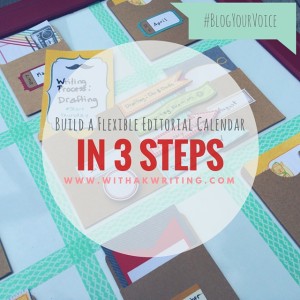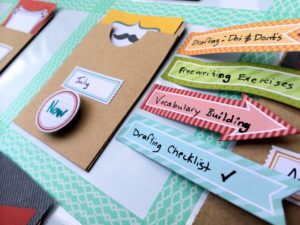How to use Revising and Editing to Clean up Your Writing Process | Tuesday Tips
Writing Process? What does that even mean?!
First things, first: a Refresher!
The Writing Process has 5 steps. I’ve talked (preached) about the first 2 steps in detail already, but I’ll give you a quick reminder anyway:
1. Prewriting – this is where you figure out and plan ahead all of the important bits and pieces before you start writing at all. DO NOT SKIP THIS STEP! Seriously, you know better.
2. Drafting – all you do here is write out the ideas you already planned – following the outline you created during the Prewriting step – and with no real concern for perfection, spelling or grammar. DON’T STRESS OUT! You’ll have time later to fix up and tweak your project. This step is all about letting your words come out naturally and following the map you already made.
3. Revising – I will explain this in a second. Trust.
4. Editing – This too! Imma ‘splain it all, I swear. Just a minute!
5. Publishing – this is the point when you finally get your words into the minds of your readers – by posting an article online, reading a speech to an audience, filming a video, sending an emailed document – you name it. That’s publishing.
[click_to_tweet tweet=”The Writing Process is called a process for a reason: if you skip steps, you’re not finished, and your work suffers” quote=”The Writing Process is called a process for a reason: if you skip steps, you’re not finished, and your work suffers”]
Clear? Clear. Moving on!
Now – Let’s talk Revising and Editing.
Because nobody’s perfect the first time out of the gate.
There are 2 reasons that I think these steps are crucial to an effective writing process:
- It takes the pressure off of you during the Drafting step and lets you feel more free and creative while you initially put your ideas on the page.
- It gives you time to clean up those ideas and make sure that they are clear and effective before you send them off into the world to be consumed.
What’s the Difference between Editing and Revising?
A lot of people will throw these two steps together while they are writing, but I would suggest that you do them separately – particularly if you are newer to the process – because they have very different purposes and require different parts of your brain to be working in order to make the steps work for you.
Revising:
This step uses deeper organizational and creative thinking. It involves 3 types of actions:
- Removing – Comb through your work and get rid of unnecessary words, ideas or even entire paragraphs that might distract the reader from your main ideas. Even if you’ve written the most beautiful prose ever written in the English language – if it doesn’t relate to your main point, get it out of there. You can always bring it back in a different piece on another day, but it’ll just be clutter and confusing if you leave it where it doesn’t belong. Cut!
- Adding – If you forgot something integral to your argument, story or explanation, you better find a place for it now. Check your outline to make certain that you said everything you meant to say.
- Moving – When you read your piece out loud (yes out loud – even if it feels weird), you might notice that some parts feel bumpy or awkward. You may also find that the piece seems a bit disjointed, or like some of the sections are in the wrong place. These are indicators that you should change the order of your ideas, paragraphs or sentences. I know it seems like major surgery, but you’ll quickly get better at tweaking the transitional parts to make certain that your sentences or paragraphs feel good in their new homes.
At the end of the Revision step, you should have everything written out in the final order, with no missing pieces and no unnecessary extras.You still don’t need to worry about perfect word-choice, spelling or fine-tuned grammar yet, so don’t stress!
It’s like the part of home-renovating when you’re tearing down or adding walls to make the rooms flow perfectly together…it’s not the step to be worrying about wallpaper or throw rugs; the small details will come later.
Take a break when you’re done, before you start the Editing process. Even if it’s only a 10 minute walk or a few candy crush levels (not that any of us play silly games on our iPhones or anything); you need to separate your mind from that organizational big-moves place before you get into the smaller details.
Editing:
This step requires a more detail-oriented part of your mind to be active. It also has 3 important types of things for you to check on:
- Word Choice – Read your work out loud again (YES out loud!), and note if any words repeat too often, or feel wrong. Remember when you were drafting and you knew there was a different word that would be perfect in that sentence, but you couldn’t think of it in the moment?
Now is the time to go searching for it. Get out your word bank and thesaurus, and start trying different words in those spots, but MAKE SURE YOU KNOW WHAT THE WORD MEANS! Never use a word from a thesaurus if you have never heard it before; chances are very high that you will use it incorrectly, and that is far worse than using a word that doesn’t sound as smarty-pantsy or lovely-fancy. I promise. - Spelling – Check for spelling errors, and be aware that some words on the page might actually be spelled like real words, so your spellcheck will miss them, but they aren’t the right spelling for the word you want to use. Now is the time to make sure that you don’t have any of those embarrassing your/you’re or two/too/to flubs, or to take that extra few minutes to double-check the spelling of antidisestablishmentarianism in the dictionary – just to be sure.
- Grammatical errors – There is no real quick fix for this one; you simply need to know the basic punctuation and sentence structure rules (I’ll be putting up some printables for this on Tuesday Tips this month, so be sure to sign up for the weekly tips in your mailbox).
A good place to start, if this is really hard for you, would be to use a grammar checker on your word processor. Keep in mind though, that you can’t always trust a machine to grasp what your intended meanings are…and grammar-checker-robots don’t understand that breaking the rules is cooler than following them sometimes. You need to know the rules before you break them stylishly though, so don’t go breaking my heart with unnecessary fragments or comma splices!
Oh My Goodness! Revising and Editing Totally Make Sense Now!
Right?
It’s not too complicated, when you break them down into parts. Just remember that Revising is like big renovations while Editing is more like changing the decorations or putting down new floor rugs.
I’ll be tackling different ways to use these steps in the Writing Process all month, so sign up for Tuesday Tips in your mailbox (put your best email address in the white box above my face in the sidebar), if you don’t want to miss some more helpful tricks and tips to polish up your writing.
Don’t forget to share, pin, like or tweet this post if you know anyone who could benefit from a little polish in their writing too – and come back for this week’s Thursday Extras post….it’ll be delicious!
xo
Kris
You mad? Excited? Have a perspective to share? Please do!
6 Comments
Leave a Comment
Want to read more? Check out these recent articles.
Let’s play a little game of 20 Questions
A few weeks ago, I went on the trip of a lifetime. I didn’t go on rides at Disneyland or see a Broadway show in New York City, & I didn’t go to Scotland to search for a family castle either. I will someday though. Sup, Clan MacLeod! I went to San Francisco; it wasn’t my first…
How to Build a Flexible Editorial Calendar in 3 Steps
Your Editorial Calendar doesn’t need to feel like a set of creativity-handcuffs. It should feel like a comforting & inspiring guideline. One that allows you to be more creative. Not stifled & uninspired. I’m an idea machine. I’ve always been a “creative person,” whatever that means, & I operated under the assumption for a long…
Why I love my Broken Voice…Finally
If you’ve been reading my blog for any time at all, you’ve heard me talk about these 2 things at least eleven times: Embracing your Voice & Finding Your Great Big Why. In my experience, these 2 things are really important Pre-Prewriting steps any writer should take in order to start really focusing in on her message & sharing it confidently.…
My Students taught me this key Lesson about Blogging & Business
Striving for perfection will not make your message stronger. In fact, it is pretty much guaranteed to keep your message bottled up, nice and tight, away from your readers. I understand why you are doing it; don’t get me wrong! I totally understand that need to just wait one more minute before sharing your voice because it’s not quite…
Series and Segments: 2 Steps to Begin a Great Editorial Calendar
Plan & Commit to an Editorial Calendar for your whole year? That can feel a little overwhelming, right? In fact, it’s downright paralyzing. I’m a bit of a commitment-phobe, so it’s really hard for me to commit to what I will be writing about EVERY week for the next year. That’s too constricting! And overwhelming…and scary. And it’s not…
Your Blog Editorial Calendar can Actually Make you Happy
Your Blog’s Editorial Calendar can change your blog from some scattered musings…to a marketing & community-building powerhouse. But its real strength lies in how it will affect you! I have the tendency to go on tangents as a storyteller. *pause for laughs* I know! It’s something that you’ve probably noticed already, but you don’t even know.…






[…] big part of the Editing step of the Writing Process is recognizing spelling errors. Some will be obvious because you […]
[…] harping on you guys to organize your ideas and plan your writing. Now, we’re talking about Revising, and I’m saying you have to re-organize your writing after the fact, if it feels […]
I’m not sure I ever realized revising and editing were different things. I do both, but I think I’ve always thought of it as editing and “fine tuning”. Good to know! 🙂
This is it! I didn’t realize it either until I really got into teaching the Writing Process to struggling students. Breaking the process into the two different brain-spaces was a HUGE difference for them, so I started doing it myself too. The difference is enormous: it allows your creative, broad thinking mind to rearrange ideas and then your detail oriented brain-space can focus on that one thing at a time, for the most effective process.
Little tricks like this one will make big changes to your writing, over time.
xo
K
Thanks for your writing tips. I find them very useful as I write my blog posts & update my book. I appreciate your clear, concise directions – with a dash of humor.
Thanks Valerie! I’m glad you’re finding the tips useful. 🙂
xo
K